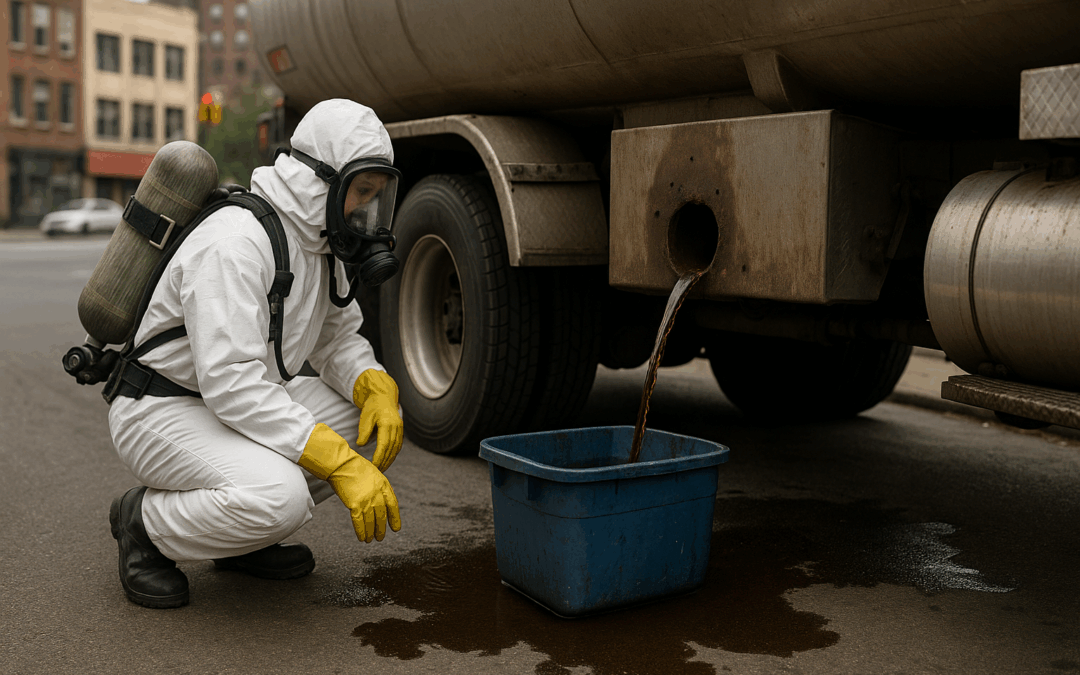How to Handle a Leaking Fuel Tank: Part 2 with The Haz Mat Guys
In this episode, Bobby Salvesen and I pick up where we left off on the messy business of leaking fuel tanks. Whether you’re in the middle of downtown chaos or out in the quiet of rural roads, the goal remains the same: stop the leak, stay safe, and get it cleaned up without making things worse. This time around, we dig deeper into how to handle these calls efficiently, with some hard-earned lessons and tactics that work in the real world.
Why Draining the Tank Matters (Especially in the City)
Draining the fuel tank might sound extreme, but it’s often the most reliable way to make sure the mess doesn’t come back to bite you. As Bobby put it, “We don’t even deal with it anymore. Just take it out.” In places like NYC, if you don’t drain it yourself, odds are someone else might do it the wrong way. And when that happens? You’re back for round two because somebody dumped 10 gallons of diesel on the highway and a passerby called it in.
In rural areas, you might get away with draining it into the woods (not that we condone that), but in cities, a drop of oil on the ground brings out every eco-warrior in the neighborhood.
First Step: Know What You’re Dealing With
Every response starts with sizing up the scene. What’s leaking? Is it gasoline, diesel, CNG, LPG? Where is it coming from – engine compartment, fuel tank, or somewhere in between? Has the vehicle flipped? Is it even a car? We’ve responded to leaking boats, planes, and even locomotives.
Your game plan changes based on this. For example, if a vehicle is upside down, the leak might be coming from a cap that wasn’t designed to hold liquid under pressure. Or if it’s from the engine compartment, it might be minor enough to avoid draining the whole tank.
Don’t Trust Estimates (Especially Not the 800-Gallon Prius)
One of our favorite pet peeves: people wildly guessing fuel amounts. If you haven’t practiced estimating spills, get a spackle bucket and learn what four gallons looks like on the ground. Nothing kills credibility faster than calling in 800 gallons from a Prius.
That said, it cuts both ways. We’ve had incidents where 10,000 gallons were actually in a sewer while the report said “maybe 10 gallons.”
Entering Like Gentlemen: Disassembly as a Third Option
When drilling or puncturing seems too rough, you can always disassemble. Many modern vehicles give access to the fuel pump through a hatch under the back seat. It’s not glamorous, but it’s smart. Use your smartphone, search the make/model plus “fuel pump replacement,” and you’ll likely find a video tutorial.
This method lets you remove the fuel cleanly. Insert a “stinger” (a narrow hose) where the pump sits to pump out the fuel from the tank’s lowest point – right where you want to be.
Important: Open all doors and windows, and wear full PPE with SCBA. We are not mechanics. We are responders, and our environment is never fully controlled. Don’t be the guy who thinks he doesn’t need a mask because “mechanics don’t wear them.”
Trucks, Saddle Tanks, and Heavy Equipment: A Different Beast
When it comes to bigger vehicles, drilling becomes the preferred method. Unlike cars, most diesel saddle tanks are above ground, easy to access, and have thick walls. Drill the top or side, not the bottom, and always check for flammable vapors with your meter. As we joke on the show, “We have pixie dust and magic hazmat powers.” But seriously, check the meter – no vapor, no boom.
Also, be mindful of DEF tanks and hydraulic reservoirs. DEF is corrosive and often leaks like a rock candy science project. And hydraulic tanks, usually steel and super tough, may require a hammer or pack tool to access. Luckily, they’re not flammable, so sparks aren’t a concern.
Don’t Forget the Transfer Valves
Some heavy equipment and tractors have multiple interconnected tanks. If you’re draining one without isolating it, the other might refill it, and boom, your leak is back. In many newer vehicles, the tanks balance inside the engine. Older ones have external hoses. Always look for a petcock valve or internal shutoff, and if you’re not sure – ask the driver.
Heavy Equipment: Lots of Diesel, Lots of Metal
Cranes, bulldozers, and excavators aren’t designed with you in mind. The tanks are built tough, and leaks usually happen from blown hoses or fittings, not the tank itself. But when the tank does go, it often holds hundreds of gallons of diesel or hydraulic fluid. These vehicles are kept on jobsites, so access is usually better. Just be ready for big quantities.
Wrapping It Up
Every leaking tank is a little different. But the core steps stay the same: identify, isolate, access, and offload. Whether you’re cracking open a Prius or emptying a 300-gallon rigged pickup tank illegally running gas across state lines, knowing your options makes all the difference.
And remember – don’t just get on the job, get into the job.



Thank you. We have a section of interstate in our jurisdiction and frequently have damaged saddle tanks leaking fuel. Does anyone have a list of tips for trying to minimize the spread or cheap ways to drain the tank ? Our fire department is somewhat small and we don’t have a lot of equipment on our fire apparatus. We are carrying collapsible kiddie pools to collect the fuel but these don’t hold that much fuel. I have searched around for “hacks” or lists of tips or tricks to evacuate the fuel with minimal cost to us. If you have any links to share I would greatly appreciate them. Thank you !